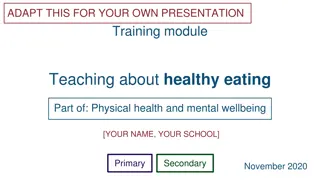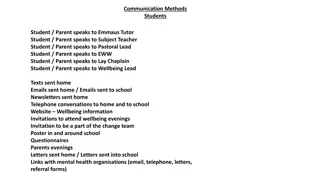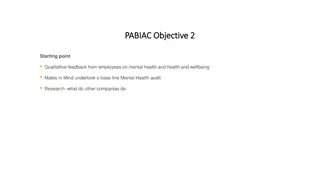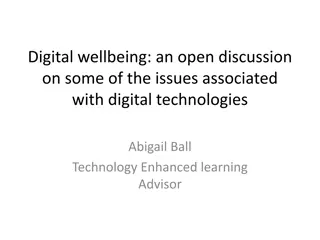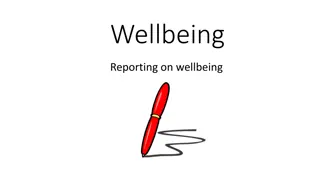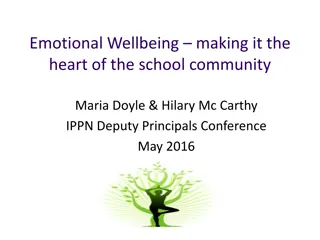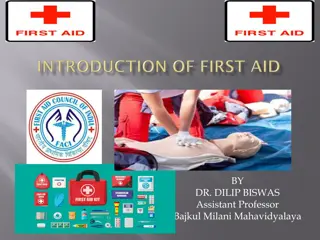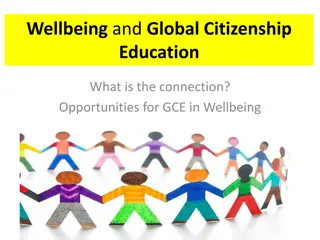Training Module on Teaching Basic First Aid for Physical Health and Wellbeing
This training module focuses on teaching basic first aid as part of physical health and mental wellbeing. It provides guidance, strategies, and resources for educators to enhance their teaching skills in this critical area. By the end of the training, participants will have a better understanding of statutory guidance, key knowledge, skills, and strategies to confidently teach basic first aid. The module also highlights the importance of linking first aid education with other relevant topics in the curriculum.
Download Presentation

Please find below an Image/Link to download the presentation.
The content on the website is provided AS IS for your information and personal use only. It may not be sold, licensed, or shared on other websites without obtaining consent from the author. Download presentation by click this link. If you encounter any issues during the download, it is possible that the publisher has removed the file from their server.
E N D
Presentation Transcript
ADAPT THIS FOR YOUR OWN PRESENTATION Training module Teaching basic first aid Part of: Physical health and mental wellbeing [YOUR NAME, YOUR SCHOOL] Primary Secondary September 2020
Contents 3 About this training module 5 Teaching the new curriculum 17 Safeguarding 19 Ground rules 22 Primary curriculum 64 Secondary curriculum 82 Examples of good practice 2
About this training module Subject leads can use the adaptable slides and activities and templates for trainers section at the end of this module to help shape training sessions for teachers. This non-statutory training module supplements the statutory guidance on teaching basic first aid, which schools should read in full. Schools can choose whether and how to follow or adapt this training module and should refer to the Early Career Framework for pedagogical guidance. 3
What you get out of today By the end of this training you should: know what is included in the statutory guidance know some key knowledge and skills to cover as part of this topic have strategies to deal with questions that come up in class feel more confident teaching about basic first aid 4
Related topics Basic first aid is related to the science curriculum as well as topics such as: health and prevention physical health and fitness healthy eating drugs, alcohol and tobacco Therefore you should: consider thematic links across key topics and the whole school when planning and delivering lessons find ways to link knowledge and vocabulary across topics 6
First aid support at [school name] Our leads [Names, contact details of first aid leads, school nurse] Our policies [Add details - e.g. school policy on PSHE, first aid, medicines policy, procedures for sanitisation of equipment, training opportunities] Specialist support [Add details - e.g. providers school already works with] Other information [Add resources] 7
First aid at [school name] Ways in which we already teach about basic first aid at our school: [Add details] [Add details] [Add details] Our first aid equipment [Add details of equipment and location] [Add details of equipment and location] [Add details of equipment and location] 8
External training and resources (1) This training module provides information about what schools can teach pupils about basic first aid. However, it should be noted that this module is not a substitute for basic first aid training. It is likely that when teaching the knowledge and skills many schools will choose to use external trainers and quality audio-visual resources from recognised expert organisations and websites, such as: British Red Cross Resuscitation Council UK St John Ambulance NHS.UK, which has informed much of the content about basic first aid in this module 9
External training and resources (2) Due to the practical nature of this topic, schools may want to incorporate the following in lessons: quality audio-visual content such as video practical demonstrations of first aid skills opportunities for pupils to practise first aid skills When using this training module teachers may therefore benefit from familiarising themselves with some core first aid skills, for example: discussing a CPR video (St John Ambulance) as a prompt considering how resources like Lifesaver and Lifesaver VR (Resuscitation Council UK) could be used in lessons 10
Whole-school approach to first aid Teaching about basic first aid should take place as part of a wider school context that promotes health and wellbeing. Teachers and pupils should be aware of provision such as: school nurse first aiders location of first aid box location of automated external defibrillator (AED) if the school has one, or if there is one nearby Teachers should also be aware of the school s medicines policy and who to approach if advice is needed. 11
Use of language and terminology While the core slides in this module contain some language and terminology that schools may wish to include in lessons, this content is primarily for teacher use in understanding what can be taught to pupils. Teachers will need to use language and terminology that is appropriate and accessible to their pupil groups. 12
Protecting our health and that of others From September 2020, schools must have regard to the new statutory guidance for teaching basic first aid. The statutory guidance explains how this teaching fits into the wider topic of health education. STATUTORY GUIDANCE Teachers should go on to talk about the steps pupils can take to protect and support their own and others health and wellbeing, including simple self-care techniques, personal hygiene, prevention of health and wellbeing problems and basic first aid. (p32) 13
Primary and secondary teaching Some slides in this training have a Primary or Secondary label to indicate that the material is usually first introduced in that phase. STATUTORY GUIDANCE Schools have flexibility to design and plan age-appropriate subject content. (p31) Using your knowledge of your pupils and school community you can: introduce secondary content in primary with pupils who need it and are ready teach the primary content in early secondary lessons to pupils who need to build knowledge before secondary content is taught 14
Pupils with SEND You will need to plan lessons to allow all pupils to access and practise the core knowledge, using your expertise as you normally would. You might want to link lesson outcomes with statutory preparing for adulthood outcomes for those with an education, health and care (EHC) plan. (See SEND code of practice, section 8.) STATUTORY GUIDANCE In special schools and for some SEND pupils in mainstream schools there may be a need to tailor content and teaching to meet the specific needs of pupils at different developmental stages. As with all teaching for these subjects, schools should ensure that their teaching is sensitive, age-appropriate, developmentally appropriate and delivered with reference to the law. (p15) 15
Teacher wellbeing The new curriculum covers a wide range of topics, some of which individual teachers might find personally challenging in different ways. It is important to feel you can ask for support or raise questions if: you have personal experience of a topic which makes teaching that content particularly challenging for you you have personal views on a topic that mean you need to discuss how you can ensure the teaching is delivered objectively Talk to your line manager, in the first instance, if you do need support. 16
Safeguarding 17
Safeguarding (1) Pupils may be affected by issues discussed in lessons. Let your designated safeguarding lead or deputy and any other relevant staff, such as pastoral leads, know what you are teaching. This will enable them to identify and speak to relevant pupils, especially those who they know may have been directly impacted by issues covered in the lessons and those with adverse childhood experiences. Teachers may need to deal with disclosures or concerns (e.g. of abuse or offending behaviour) in a way that safeguards pupils in line with school policies, especially the child protection policy. 18
Ground rules 19
Create class ground rules Clear class ground rules can help when teaching about sensitive topics. They also support confidentiality and safeguarding of pupils. Good practice is for ground rules to be: discussed and understood by all clear and practical modelled by the teacher followed consistently and enforced updated when needed visible in lessons (for example, posters) 20
Example ground rules Respect privacy. We can discuss examples but do not use names or descriptions that identify anyone, including ourselves. Listen to others. It is okay to disagree with each other, but we should listen properly before making assumptions or deciding how to respond. When disagreeing, challenge the statement not the person. No judgement. We can explore beliefs and misunderstandings about a topic without fear of being judged. Choose level of participation. Everyone has the right to choose not to answer a question or join discussion. We never put anyone on the spot (no personal questions or pressure to answer). 21
Introducing basic first aid STATUTORY GUIDANCE Know concepts of basic first-aid, for example dealing with common injuries, including head injuries. Explain that basic first aid teaches us when and how to help someone who is suddenly injured or ill. This can mean: carrying out first aid on ourselves or another person explaining to someone else how to carry out first aid calling for help from adults or emergency services Explore situations where basic first aid might be needed (e.g. the scenarios in this module). Explain that pupils will learn when and how they might help, but they should still speak to an adult if they or someone they know is in pain or has hurt themselves. Primary 24
Putting safety first STATUTORY GUIDANCE Know concepts of basic first-aid, for example dealing with common injuries, including head injuries. Explain that pupils should always check whether it is safe for them and other people if they do basic first aid. For example, they should check for a risk of: being cut by broken glass falling from a height something falling onto them busy traffic coming into contact with fire or chemicals If there has been an accident, or there is a serious danger to them or another person, pupils should always find a safe space and call 999. Primary 25
Minor and major injuries STATUTORY GUIDANCE Know concepts of basic first-aid, for example dealing with common injuries, including head injuries. Explain that basic first aid allows us to: help when someone has a minor injury or illness keep someone with a more serious injury safe while they are waiting for emergency help (if it is safe to do so) Teach that it is not always obvious whether an injury is minor or major. Explain that when they learn about common injuries, pupils will also learn to look out for signs that they should get emergency help. Remind pupils that they should always tell an adult if they or somebody else is hurt or ill. Primary 26
Medication STATUTORY GUIDANCE Know concepts of basic first-aid, for example dealing with common injuries, including head injuries. Explain that: the painkillers paracetamol and ibuprofen are often used for pain caused by minor injuries antihistamines are used to treat allergies Stress that pupils should: only take painkillers with the knowledge, consent and guidance of a parent/guardian/doctor follow packaging instructions for recommended dose (which varies according to age) never take aspirin, if they are under 16 (as it can damage their liver and brain) Primary 27
Antiseptic cream STATUTORY GUIDANCE Know concepts of basic first-aid, for example dealing with common injuries, including head injuries. Teach that antiseptic creams are used to treat minor injuries such as cuts, grazes, burns and scalds, and insect bites. They help clean wounds and protect against infection by killing bacteria around the wound. Explain that antiseptic cream should not be used on wounds that are going to be covered by a dressing. This is because they can keep the skin wet, damage it and slow down healing. (Reference: NHS website.) Primary 28
Dressings and bandages STATUTORY GUIDANCE Know concepts of basic first-aid, for example dealing with common injuries, including head injuries. Introduce pupils to a range of dressings (e.g. plasters) and bandages (e.g. roller bandage). Explore situations in which pupils might need to use dressings and bandages. Teach that dressings are sterile pads that we put onto wounds to promote healing, keep wounds clean and prevent further harm. Bandages are used to hold dressings in place, support injured joints and control bleeding. Provide pupils with opportunities to practise applying dressings and bandages. Primary 29
Applying dressings STATUTORY GUIDANCE Know concepts of basic first-aid, for example dealing with common injuries, including head injuries. Explain that when applying a dressing, pupils should: stop bleeding by putting pressure on the wound and lifting it above the heart clean the wound under running water (for 5 to 10 minutes) pat dry using a clean cloth (but nothing fluffy) choose a dressing that is slightly bigger than the wound they are to cover hold the dressing at the edges and not touch the part that will cover the wound replace dressings when they are dirty or wet, or when blood soaks through Primary 30
Using bandages STATUTORY GUIDANCE Know concepts of basic first-aid, for example dealing with common injuries, including head injuries. Give pupils a chance to practise using a bandage to secure a dressing on each other. Explain they should: support the person s limb start from the front and injured side of the person spiral the bandage around the limb tightly, but without restricting circulation leave toes or fingers uncovered fasten the bandage with pins or tape, or tuck the bandage into itself if no pins or tape are available Explain that many dressings are self-adhesive and do not require a bandage to hold them in place. Primary 31
Teaching common injuries STATUTORY GUIDANCE Know concepts of basic first-aid, for example dealing with common injuries, including head injuries. The following slides introduce the concept of basic first aid for common injuries. As well as setting out steps pupils can take if an injury is minor and it is safe for them to carry out first aid, the slides also give more advanced advice on when to get emergency help. At primary level, teachers will need to use their understanding of their class s developmental level to determine whether it is appropriate to teach the more advanced information for each injury. Primary 33
Wasp and bee stings (1) STATUTORY GUIDANCE Know concepts of basic first-aid, for example dealing with common injuries, including head injuries. Teach that bees and wasps have stingers that hurt and cause a red lump when they prick our skin. Explain that bees can only sting once, and their sting is acidic. They leave their stinger in the skin. Wasps can sting more than once, and their sting is alkaline. They do not leave their stinger in the skin. To treat a wasp or bee sting, pupils should: 1. remove the stinger (if there is one) 2. wash the area with soap and water 3. apply a cold cloth (for at least 10 minutes) 4. not scratch the affected area Primary 34
Wasp and bee stings (2) STATUTORY GUIDANCE Know concepts of basic first-aid, for example dealing with common injuries, including head injuries. Explain that emergency treatment is required for a severe allergic reaction (e.g. difficulty breathing, swollen face, being sick, loss of consciousness). Teach that pupils may also need medical help if: symptoms get worse over a number of days the wound becomes infected (e.g. it is inflamed and surrounded by a thick yellow liquid called pus) they are stung in their mouth, throat or around their eyes Primary 35
Cuts and grazes (1) STATUTORY GUIDANCE Know concepts of basic first-aid, for example dealing with common injuries, including head injuries. Explain that most cuts and grazes are not deep and will heal after a few days, if we follow these steps. 1. Stop the bleeding by pressing a hand or clean cloth against the wound for a few minutes. 2. Clean the wound under a running tap and pat it dry with a clean cloth. Do not use an antiseptic, as this can damage the skin and slow down healing. 3. Apply a plaster that is slightly bigger than the wound. Do not touch the part that covers the wound. Replace plasters when wet or dirty, or when blood shows through. Primary 36
Cuts and grazes (2) STATUTORY GUIDANCE Know concepts of basic first-aid, for example dealing with common injuries, including head injuries. Explain that wounds sometimes get infected by bacteria if not properly treated. Pupils might need medical help if they show signs of infection (swelling, redness, pus, high temperature, swollen glands). Teach that pupils should get emergency help if: a wound is large and deep bleeding does not stop there may be something stuck in the wound (e.g. metal or glass) blood is bright red and spurting out of the wound (this could mean an artery has been cut) the wound is to the face (to prevent scarring) Primary 37
Nosebleeds (1) STATUTORY GUIDANCE Know concepts of basic first-aid, for example dealing with common injuries, including head injuries. Teach that nosebleeds are caused by damage to the inside of the nose. Explain that to treat a nosebleed pupils should: sit or stand up straight (they should not lie down) pinch above their nostrils for 10 to 15 minutes lean forward and breathe through their mouth place an ice pack (or similar item, e.g. a bag of frozen peas) at the top of their nose Primary 38
Nosebleeds (2) STATUTORY GUIDANCE Know concepts of basic first-aid, for example dealing with common injuries, including head injuries. Explain that for 24 hours after a nosebleed, pupils should not: blow or pick their nose drink hot drinks lift anything heavy do any exercise pick any scabs that emerge Teach that nosebleeds are common among children, but they usually grow out of them by the age of 11. Explain that nosebleeds sometimes require medical attention, but this is more common for adults. Primary 39
Headaches (1) STATUTORY GUIDANCE Know concepts of basic first-aid, for example dealing with common injuries, including head injuries. Explain that headaches can be caused by factors such as dehydration, stress, a cold or staring at a screen for too long. They are usually short term, go away by themselves and are not a sign of anything serious. Explore ways pupils might deal with a headache, e.g.: drinking plenty of water to stay hydrated avoiding anything stressful doing some light exercise in the fresh air resting, if they have a cold or the flu Teach that parents/guardians may take them to see a GP if they keep getting headaches or have other symptoms (e.g. they are vomiting). Primary 40
Headaches (2) STATUTORY GUIDANCE Know concepts of basic first-aid, for example dealing with common injuries, including head injuries. Teach that pupils should never take painkillers for a headache without the knowledge and instruction of a parent/guardian/doctor. Explain that they should call 999 if someone has a headache that is extremely painful and is accompanied by: difficulty talking or remembering things loss of vision drowsiness or confusion high temperature, shivers, a stiff neck or rash the white of the eye turning red Primary 41
Head injuries (1) STATUTORY GUIDANCE Know concepts of basic first-aid, for example dealing with common injuries, including head injuries. Teach that banging our head (e.g. by falling over or something hitting our head) can cause a head injury. Reassure pupils that most head injuries are minor, but they should always tell an adult if they bang their head. After banging their head, they can also: hold an ice pack to the head to reduce swelling rest and avoid stress stay close to an adult for 24 hours - so they can continue to check for signs of serious injury Pupils should not take painkillers without the knowledge and instruction of a parent/guardian. Primary 42
Head injuries (2) STATUTORY GUIDANCE Know concepts of basic first-aid, for example dealing with common injuries, including head injuries. Explain that pupils should always call 999 if someone has: been in a serious accident (e.g. a car crash) been knocked out (even if they wake up) fluid or blood coming from their ears or nose numbness or problems walking, balancing, understanding or speaking changes to their usual behaviour memory loss continuous vomiting after the injury trouble staying awake seizures Primary 43 .
Sprains STATUTORY GUIDANCE Know concepts of basic first-aid, for example dealing with common injuries, including head injuries. Teach that in day-to-day activity (e.g. playing sports), we can tear or twist ligaments, which hold together joints such as knees, ankles and wrists. Explain that sprains cause pain around an affected ligament, and the area becomes swollen or bruised. Usually, we can treat a strain at home if we: rest, so that we do not put weight on the injury put an ice pack on the area every 2 to 3 hours put a bandage around the injury to support it keep it raised on a pillow as much as possible keep moving the joint, once pain dies down (to prevent stiffness) Primary 44
Broken bones STATUTORY GUIDANCE Know concepts of basic first-aid, for example dealing with common injuries, including head injuries. Teach that signs of a broken bone include: extreme pain in an injury after an incident a large amount of swelling or bruising a bone looking like it is at a strange angle inability to use the injured part of the body Explain that it is important to treat broken bones as soon as possible, so pupils should call 999 even if they only suspect a bone may be broken. They should: tell the person to keep the injury still support the injury with soft items (e.g. cushions) try to stop any bleeding while waiting for help Primary 45
Vomiting STATUTORY GUIDANCE Know concepts of basic first-aid, for example dealing with common injuries, including head injuries. Teach that vomiting is very common in children and is usually caused by a stomach infection. It usually stops within a few days. Pupils should tell an adult if they or someone they know has vomited. They should also: get plenty of rest drink lots of fluids stay at home and wash their hands regularly (to prevent spreading infection) not share items like towels or cutlery A parent/guardian may take a child to see a GP if a child does not stop vomiting or has other symptoms. Primary 46
Eye injuries (1) STATUTORY GUIDANCE Know concepts of basic first-aid, for example dealing with common injuries, including head injuries. Explain that if we get something in our eye it is usually minor and the injury heals within a day. Teach that we can treat a minor eye injury at home by: washing the eye with clean water (not hot) if possible, running the eye under a tap for 20 minutes (only using a mild flow), holding the eye open trying not to rub the eye until it is better Primary 47
Eye injuries (2) STATUTORY GUIDANCE Know concepts of basic first-aid, for example dealing with common injuries, including head injuries. Explain that it is important to get emergency help if: a strong chemical has got in the eye (keep rinsing the eye with water while waiting for help) something has pierced the eye something has hit the eye at high speed We should also get emergency help if, after an injury: our eyesight changes we feel sick, have a headache, high temperature or sensitivity to light we cannot move the eye blood or pus is coming from the eye Primary 48
Burns and scalds (1) STATUTORY GUIDANCE Know concepts of basic first-aid, for example dealing with common injuries, including head injuries. Explain that burns and scalds are skin damage caused by heat. Burns are caused by dry heat (e.g. fire). Scalds are caused by wet heat (e.g. boiling water). Teach pupils that if someone is burned, they should: get them away from the source of heat run the burn under cool/lukewarm water for 20 minutes (and not use ice or greasy substances) remove clothing or jewellery near the burn (but not remove anything that is stuck to the skin) keep the person warm with a blanket cover the burn with cling film or a clean plastic bag Primary 49
Burns and scalds (2) STATUTORY GUIDANCE Know concepts of basic first-aid, for example dealing with common injuries, including head injuries. Teach that some minor burns can be treated at home, if the burn is kept clean. People should not apply creams or burst any blisters that appear. Explain that pupils should always get emergency medical help for: any burns that are bigger than the person s hand chemical and electrical burns burns that cause white or charred skin burns that cause blisters on the face, hands, arms, feet, legs or genitals people who have breathed in fumes or smoke Primary 50


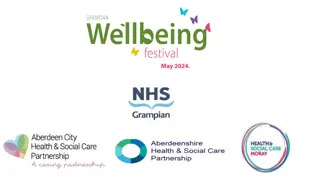
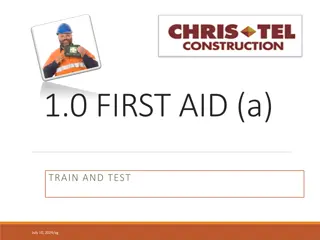
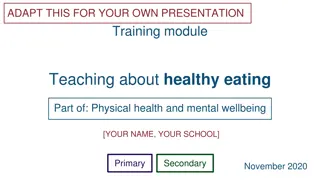
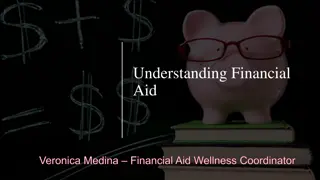
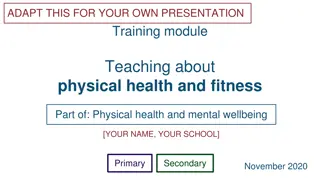
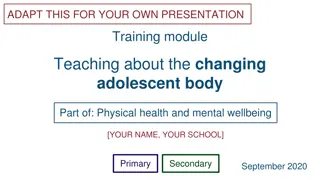
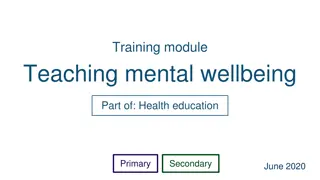
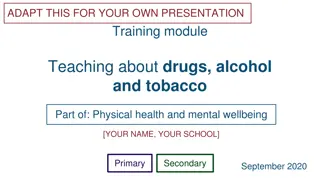
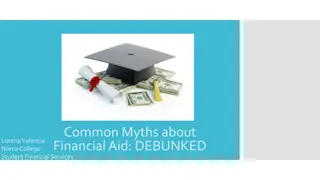
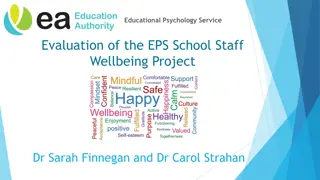

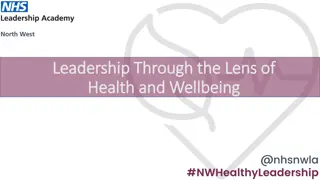
![Teaching Health and Prevention at [Your School]: Training Module for Physical Health and Mental Wellbeing](/thumb/167013/teaching-health-and-prevention-at-your-school-training-module-for-physical-health-and-mental-wellbeing.jpg)
